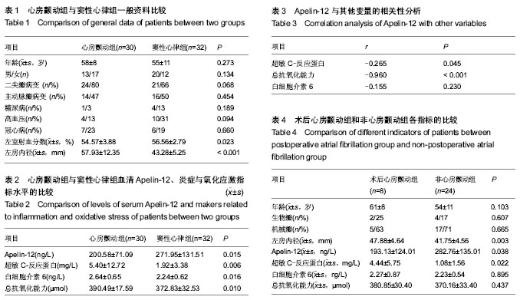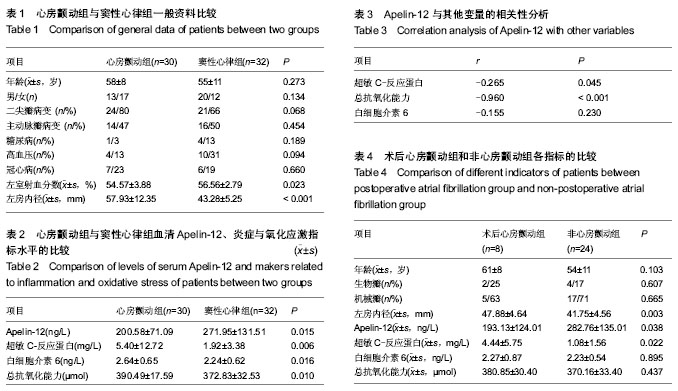| [1] Chugh SS,Havmoeller R,Narayanan K,et al.Worldwide epidemiology of atrial fibrillation: a Global Burden of Disease 2010 Study. Circulation.2014;129(8):837-847.
[2] 黄从新,张澍,马长生,等.心房颤动:目前的认识和治疗建议—2012[J].中华心律失常学杂志,2012,16(4):246-289.
[3] Wu N,Xu B,Xiang Y,et al.Association of inflammatory factors with occurrence and recurrence of atrial fibrillation: a meta-analysis.Int J Cardiol.2013;169(1):62-72.
[4] Kumagai K,Nakashima H,Saku K.The HMG-CoA reductase inhibitor atorvastatin prevents atrial fibrillation by inhibiting inflammation in a canine sterile pericarditis model.Cardiovasc Res.2004;62(1):105-111.
[5] Youn JY,Zhang J,Zhang Y,et al.Oxidative stress in atrial fibrillation: an emerging role of NADPH oxidase.J Mol Cell Cardiol.2013;62:72-79.
[6] Elahi MM,Flatman S,Matata BM.Tracing the origins of postoperative atrial fibrillation: the concept of oxidative stress-mediated myocardial injury phenomenon.Eur J Cardiovasc Prev Rehabil.2008;15(6):735-741.
[7] Tatemoto K,Hosoya M,Habata Y,et al.Isolation and characterization of a novel endogenous peptide ligand for the human APJ receptor.Biochem Biophys Res Commun.1998; 251(2):471-476.
[8] Habchi M,Duvillard L,Cottet V,et al.Circulating apelin is increased in patients with type 1 or type 2 diabetes and is associated with better glycaemic control. Clin Endocrinol (Oxf). 2014;81(5):696-701.
[9] Przewlocka-Kosmala M,Kotwica T,Mysiak A,et al.Reduced circulating apelin in essential hypertension and its association with cardiac dysfunction.J Hypertens.2011;29(5):971-979.
[10] Kadoglou NP,Lampropoulos S,Kapelouzou A,et al.Serum levels of apelin and ghrelin in patients with acute coronary syndromes and established coronary artery disease- KOZANI STUDY.Transl Res.2010;155(5):238-246.
[11] Pisarenko OI,Lankin VZ,Konovalova GG,et al.Apelin-12 and its structural analog enhance antioxidant defense in experimental myocardial ischemia and reperfusion. Mol Cell Biochem.2014;391(1-2):241-250.
[12] Lim R,Barker G,Riley C,et al.Apelin is decreased with human preterm and term labor and regulates prolabor mediators in human primary amnion cells.Reprod Sci.2013;20(8):957-967.
[13] Pan CS,Teng X,Zhang J,et al.Apelin antagonizes myocardial impairment in sepsis.J Card Fail.2010;16(7):609-617.
[14] Foussal C,Lairez O,Calise D,et al.Activation of catalase by apelin prevents oxidative stress-linked cardiac hypertrophy. FEBS Lett.2010;584(11):2363-2370.
[15] Than A,Zhang X,Leow MK,et al.Apelin attenuates oxidative stress in human adipocytes.J Biol Chem.2014;289(6):3763-3774.
[16] Ellinor PT,Low AF,Macrae CA.Reduced apelin levels in lone atrial fibrillation.Eur Heart J.2006;27(2):222-226.
[17] Falcone C,Buzzi MP,D'Angelo A,et al.Apelin plasma levels predict arrhythmia recurrence in patients with persistent atrial fibrillation.Int J Immunopathol Pharmacol.2010;23(3):917-925.
[18] Wann LS,Curtis AB,Ellenbogen KA,et al.2011 ACCF/AHA/HRS focused update on the management of patients with atrial fibrillation (update on Dabigatran): a report of the American College of Cardiology Foundation/American Heart Association Task Force on practice guidelines. Circulation. 2011;123(10):1144-1150.
[19] Ellinor PT,Low A,Patton KK,et al.C-Reactive protein in lone atrial fibrillation.Am J Cardiol.2006;97(9):1346-1350.
[20] Mathew JP,Fontes ML,Tudor IC,et al.A multicenter risk index for atrial fibrillation after cardiac surgery.JAMA. 2004;291(14): 1720-1729.
[21] Osranek M,Fatema K,Qaddoura F,et al.Left atrial volume predicts the risk of atrial fibrillation after cardiac surgery: a prospective study.J Am Coll Cardiol.2006;48(4):779-786. |

